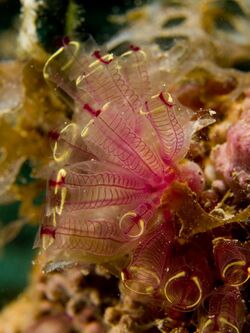Biology:Clavelina picta
| Clavelina picta | |
|---|---|

| |
| Scientific classification | |
| Domain: | Eukaryota |
| Kingdom: | Animalia |
| Phylum: | Chordata |
| Subphylum: | Tunicata |
| Class: | Ascidiacea |
| Order: | Aplousobranchia |
| Family: | Clavelinidae |
| Genus: | Clavelina |
| Species: | C. picta
|
| Binomial name | |
| Clavelina picta (Verrill, 1900)[1]
| |
| Synonyms | |
|
Aplidium crassum Herdman, 1886 | |
Clavelina picta, common name the painted tunicate, is a species of tunicate (sea squirt), in the genus Clavelina (the "little bottles"). These animals, like all ascidians, are sessile filter feeders.
Description
Clavelina picta have variable cool colours. The rims of the siphons are reddish to dark purple. Their bodies are translucent.[2]
Clavelina picta are invertebrate filter feeders that feed by inducing a current into the branchial cavity from the incurrent siphon, with the help of the endostyle using cilia.[3] Mucus glands in the endostyle secrete mucus used to filter through the incoming water and food particles. Once sorted, the mucus is moved by cilia to move food into the esophagus along the dorsal groove. The diet of a tunicate is mostly made of algae and plankton. Tunicates also have tentacles that keep larger particles from entering the oral siphon.
Tunicates, including C. picta, also have defensive measures such as acids or allelochemicals to inhibit microbes and predator organisms from infecting or consuming them.[4] [5] These properties make them valuable to pharmaceutical companies. Vanadium, an elemental metal is also found in some tunicates, including C. picta, as a metabolic poison and this can help make them unpalatable to predators.[6]
Taxonomy
Under the phylum Chordata, the Urochordates or Tunicata, do not have vertebrae but as larvae they have dorsal nerve cords and notochords. Tunicate larvae are also free-swimming and look like tadpoles. Larvae lose these distinctions when developing into an adult.[7] This is hypothesized to be related to the habitat tunicates have adapted to. Tunicates are the closest living relative to vertebrates.[8]
Distribution
This species is found in the waters of Florida, Bahamas, and the Caribbean.[2] Colonies are found in or around reefs and are mesopelagic benthic organisms staying towards the shore.
Habitat
Clavelina picta often occurs in large clusters attached to black coral, sponges, and gorgonians. Colonies may contain hundreds of individuals.[2] C. picta form colonies that may contain hundreds of individuals. Larvae settle and use papillae to attach to a surface. The larvae use sensory organs to find a suitable habitat. These larval organs include eye spots and otoliths. The eye spot is used to detect light and otoliths to help orient the larvae to gravity.[9]
Because of the toxicity or odor of their skin, tunicates have few predators but sharks, reef fish, sea stars, snails, and crabs will sometimes eat tunicates.[10]
Reproduction
Clavelina picta can reproduce through asexual and sexual means. Asexual reproduction occurs through blastogenesis.[11] Blastogenesis is reproduction through budding where somatic tissues develop into an embryo. Sexual reproduction in tunicates occurs by a single egg being fertilized. For the most part, tunicates are hermaphroditic, meaning they possess sperm and egg to reproduce independently. Fertilization occurs in the water through spawning, where the tunicates will release sperm and eggs to be fertilized and the larvae will settle next to adults.[12]
References
- ↑ WoRMS - World Register of Marine Species - Clavelina picta (Verrill, 1900)
- ↑ Jump up to: 2.0 2.1 2.2 Almost Us!? Sea Squirts, Tunicates, Ascidians, Subphylum Urochordata, Phylum Chordata pt 2
- ↑ Macginitie, G. E. (December 1939). "The Method of Feeding of Tunicates" (in en). The Biological Bulletin 77 (3): 443–447. doi:10.2307/1537654. ISSN 0006-3185. https://www.journals.uchicago.edu/doi/10.2307/1537654.
- ↑ Mydlarz, Laura D.; Jones, Laura E.; Harvell, C. Drew (2006). "Innate Immunity, Environmental Drivers, and Disease Ecology of Marine and Freshwater Invertebrates". Annual Review of Ecology, Evolution, and Systematics 37: 251–288. doi:10.1146/annurev.ecolsys.37.091305.110103. ISSN 1543-592X. https://www.jstor.org/stable/30033833.
- ↑ Ramesh, Chatragadda; Tulasi, Bhushan Rao; Raju, Mohanraju; Thakur, Narsinh; Dufossé, Laurent (2021-05-26). "Marine Natural Products from Tunicates and Their Associated Microbes" (in en). Marine Drugs 19 (6): 308. doi:10.3390/md19060308. ISSN 1660-3397. PMID 34073515.
- ↑ Stoecker, D (1980). "Relationships Between Chemical Defense and Ecology in Benthic Ascidians" (in en). Marine Ecology Progress Series 3: 257–265. doi:10.3354/meps003257. ISSN 0171-8630. Bibcode: 1980MEPS....3..257S. http://www.int-res.com/articles/meps/3/m003p257.pdf.
- ↑ Holland, Linda Z. (February 2016). "Tunicates" (in en). Current Biology 26 (4): R146–R152. doi:10.1016/j.cub.2015.12.024. PMID 26906481.
- ↑ Racioppi, Claudia; Valoroso, Maria Carmen; Coppola, Ugo; Lowe, Elijah K.; Brown, C. Titus; Swalla, Billie J.; Christiaen, Lionel; Stolfi, Alberto et al. (December 2017). "Evolutionary loss of melanogenesis in the tunicate Molgula occulta" (in en). EvoDevo 8 (1): 11. doi:10.1186/s13227-017-0074-x. ISSN 2041-9139. PMID 28729899.
- ↑ Racioppi, Claudia; Valoroso, Maria Carmen; Coppola, Ugo; Lowe, Elijah K.; Brown, C. Titus; Swalla, Billie J.; Christiaen, Lionel; Stolfi, Alberto et al. (December 2017). "Evolutionary loss of melanogenesis in the tunicate Molgula occulta" (in en). EvoDevo 8 (1): 11. doi:10.1186/s13227-017-0074-x. ISSN 2041-9139. PMID 28729899.
- ↑ Holland, Linda Z. (2016-02-22). "Tunicates" (in en). Current Biology 26 (4): R146–R152. doi:10.1016/j.cub.2015.12.024. ISSN 0960-9822. PMID 26906481.
- ↑ Kowarsky, Mark; Anselmi, Chiara; Hotta, Kohji; Burighel, Paolo; Zaniolo, Giovanna; Caicci, Federico; Rosental, Benyamin; Neff, Norma F. et al. (January 2021). "Sexual and asexual development: two distinct programs producing the same tunicate" (in en). Cell Reports 34 (4): 108681. doi:10.1016/j.celrep.2020.108681. PMID 33503429.
- ↑ Castilla, Juan Carlos; Manríquez, Patricio H.; Delgado, Alejandro P.; Gargallo, Ligia; Leiva, Angel; Radic, Deodato (2007-11-13). "Bio-foam enhances larval retention in a free-spawning marine tunicate" (in en). Proceedings of the National Academy of Sciences 104 (46): 18120–18122. doi:10.1073/pnas.0708233104. ISSN 0027-8424. PMID 17984045. Bibcode: 2007PNAS..10418120C.
Wikidata ☰ Q4911276 entry
 |

